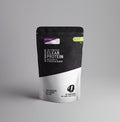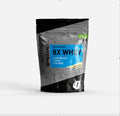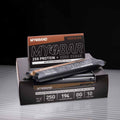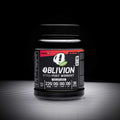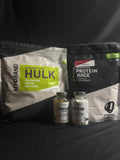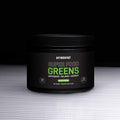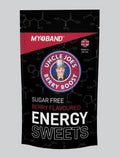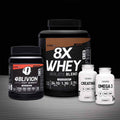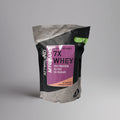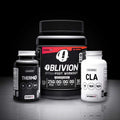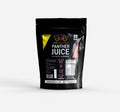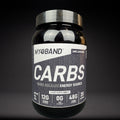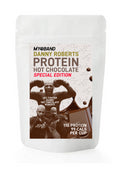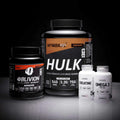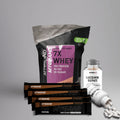How supplements can aid meal plans for lean muscle gain
Posted by PROPROTEIN LTD ADMIN

There are multiple articles and guides out there for bulking. Many of them suggest slightly different mealtimes, macro ratios and training loads, so it can be hard to know which one to follow. So where do we start?
In order to set attainable fitness goals, your daily lifestyle needs to be considered when planning meals and training programs. Just ask yourself, is having 8 meals per day doable for you? Of course, everyone is different, but on top of studies, work, sport, and social life, this can be difficult for lots of people. This article will outline science-driven, achievable ways to gain lean muscle by incorporating supplements into your diet, as well as our suggestions for future meal plans.
BULKING basics:
The energy obtained from our diet is measured in calories. To gain weight, more calories need to be consumed than burned. This is called a calorie surplus and is used alongside resistance training when bulking up. Without sufficient training, consuming a calorie surplus will still build body mass, however, less muscle will be gained. During the bulking season, the aim is to gain approximately 0.25–0.50% of body weight per week (8). The cutting phase involves a calorie deficit (whereby fewer calories are consumed than burned) to loose fat making the lean muscle more prominent (1).
Lean muscle is jam-packed with contractile tissue, which assists to generate force by shortening and that’s how we lift things. Other muscles contain a higher level of fat and connective tissue. Building lean mass will result in gaining less fat around and within your muscles. Having more muscle and less fat will increase your metabolic rate because muscles use up more energy.
TYPES of bulking:
Dirty Bulk
When it comes to a dirty bulk, no foods are o limits. This is normally used as the perfect excuse to consume the ‘unhealthy foods’ which are avoided during the cutting phase. Although most of the foods eaten during a dirty bulk are calorie-dense, they will likely have very low nutritious value. Dirty bulking results in gaining higher levels of fat and can also lead to serious health implications.
Clean Bulk
A clean bulk involves maintaining a calorie surplus while consuming healthy foods (19). This will help to gain more lean mass rather than fat, leaving you much healthier, stronger and with less work to do during the cutting phase.
CALORIE needs
127 competitive male bodybuilders completed an online survey involving their training practices during the bulking season (3). Results show that bodybuilders generally complete 5-6 resistance training sessions per week, each lasting 40-90 minutes. One to two cardio sessions per week during the bulking phase is okay, just make sure the extra calories burned are compensated for to maintain a calorie surplus. On average, bodybuilders consume approximately 3800 kcal/day during bulking season and 2400 kcal/day during cutting (2).
To gain lean mass, you should increase your maintenance calorie intake by 20% (multiply by 1.2) (4). The following steps are used to calculate the calories needed to maintain a calorie surplus:
- Estimate resting metabolic rate (RMR)
- Calculate daily energy expenditure
- Estimate the number of calories burned during exercise
- Calculate maintenance calorie intake
- Increase calorie intake
(Refer to Appendix 1. for step-by-step instructions using worked examples).
MACRONUTRIENT ratios
The three macronutrients (protein, carbohydrates, and fats) each have a different role in the body. Carbohydrates are stored as glycogen, which can be quickly broken down into glucose for immediate energy. Fat is considered a long-term energy source and protein is essential to build and repair tissues within the body (4).
A past review provided the following recommendations regarding the composition of a bodybuilder's diet during the bulking season: 55-60% carbohydrate, 25-30% protein and 15-20% fat (5). Using grams is the easiest way to track the portions of each macronutrient you consume.
Refer to Appendix 2. for the equations used to calculate macronutrien ratio values.

To maintain weight when power and strength training, the recommended carbohydrate and protein requirement is 5-7 g/kg BW and 1.4-2.0 g/kg BW respectively (4). Similar to the increase in calorie intake, you should consume 20% more carbohydrates and protein than usual when bulking. The recommended fat intake is the amount left over once protein and carbs have been considered.
SUPPLEMENTS that aid bulking
It can be hard to attain dietary requirements solely through food, especially when bulking. Supplements can help to reach these recommendations as well as speed up recovery time, allowing for increased training loads.
Creatine
Creatine is naturally made within our bodies to aid with energy production. Supplementing with 0.3g/kg/day of creatine for 4-5 consecutive days is recommended as the ideal amount for creatine loading, one of the fastest ways to saturate your muscle creatine stores (7). However, there is new research to suggest that taking a maintenance dose (0.03g/kg/day) will have the same effect over time and therefore creatine loading is not necessary. Increased muscle phosphocreatine stores will enable more ATP to be produced, therefore giving the body more energy for high-intensity workouts (10).
Caffeine
A past study examined the effect of caffeine during resistance-training exercises on volitional failure. The results showed that the caffeine group achieved significantly higher reps than the placebo group, with no significant difference in RPE between both groups (9). These findings suggest that caffeine can delay fatigue during high-intensity resistance training, resulting in more reps completed for the same amount of effort.
A recent review stated that bodybuilders in bulking season experience ergogenic aid during resistance training, by consuming 5-6 mg/kg of caffeine pre-workout (8). To maximise the effects, cycling this supplement is especially important when taking such high dosages (6).
Branched chain amino acids (BCAA)
As protein is one of three macronutrients, it is an essential part of both bulking and cutting. Protein can be made up by 20 different amino acids, 9 of which must be obtained through our diet. Three of these essential amino acids are BCAAs which help prevent muscle breakdown during high-intensity exercise (4). BCAA supplements can be used to reach the recommended protein requirements whilst training. Whey protein is an example of a fast-acting protein, which is great to consume immediately after a workout when your body needs to repair the most.
MYOBAND protein supplements (measures per 1 serving):
| Calories Protein (g) Carbs (g) Fat (g) |
| Hulk Protein | 282 kcal | 27 | 37.75 | 3.23 |
| 8X Whey Isolate | 117 kcal | 24.6 | 1.8 | 1.3 |
| Oblivion Plus | 30 kcal | 12.5 | 0.09 | 0 |
| MYOBAR | 192 kcal | 25.4 | 10.15 | 5.85 |
(18)
BEST foods for clean bulking
Glycaemic index (GI) is a 0-100 scale used to rank foods based on how quickly they increase blood sugar levels within the body (12). Higher GI carbohydrates can be digested quicker than low GI carbs. Simple carbohydrates (composed of only 1- to 2- units of sugar) can be broken down quickly, providing instant energy. Carbohydrates with longer sugar molecules (aka complex carbs) are harder to break down and therefore have a lower GI than simple carbs. It is useful to know how the body responds to certain foods when choosing pre- and post-exercise snacks.
It is recommended that low GI foods should be consumed before exercise to help maintain blood sugar and energy levels throughout the session (4). Moderate to high GI carbohydrates are ideal for during exercise because they will be quickly absorbed by the working muscles, helping to replenish glycogen stores and blood glucose. There is controversy as to whether the same theory should apply immediately after exercise. Although high GI foods consumed post-exercise will kick-start glycogen recovery, past studies have shown that low and high GI foods provide no significant difference in terms of recovery after 24 hours (13).
Milk can be used as a recovery drink to restore glycogen and promote rehydration within the body. Drinking 237 ml of milk within an hour after resistance training has proven to increase muscle protein synthesis (11). This is mainly due to the proteins found in milk, such as whey and casein. These proteins contain several amino acids including leucine, (one of the 3 essential BCAAs) which is particularly important for gaining muscle. The following foods supply 2g of leucine and 20g of protein: 85g cheddar cheese, 450g plain yogurt, 3 eggs (4). Egg whites are especially good for lean muscle gain because they do not contain fat and store the majority of the protein found in whole eggs.
Salmon and tuna provide large amounts of omega-3 fatty acids which aid muscle health and potentially muscle gain (15). Both chicken and turkey breast contain high amounts of protein and the B vitamin, niacin. Within the body niacin helps to process fats and carbohydrates as well as maintain healthy cells (14).
Protein is required for the body to gain muscle, whilst carbohydrates and fats provide the energy needed to train. Consider the foods mentioned previously when planning your bulking diet to help maximise energy and nutritional value.
Foods to have LESS often when clean bulking
Foods such doughnuts, cake and ice cream are considered empty calories, whereby the calorie content is high and the nutritional value is very low. 500 calories of doughnuts do not have the same effect within the body as 500 calories of a chicken and lentil salad. The doughnuts contain less amounts of macronutrients, and therefore limit the effect of increasing lean muscle mass. Excessive alcohol consumption has also been proven to suppress the ability to gain skeletal muscle (16).
MEAL PLAN example
As mentioned previously, the main goal during the clean bulking season is to maintain a calorie surplus in order to gain lean mass. Other factors such as family and work should be considered when choosing the best meal plan for yourself. If it is unrealistic for you to eat 8 times a day, plan for fewer meals and use supplements to meet the dietary requirements instead.
Here are a few example meal plans, each proving 3500 kcal/day, to get you brainstorming!


TAKE HOME MESSAGE
Clean bulking helps to gain more lean mass rather than fat, leaving you with less work to do during the cutting phase. Supplements can help to reach dietary requirements as well as to enhance performance. There are multiple sources with different recommendations about macronutrients within a diet, which may become confusing.
If you haven’t noticed, the values calculated from reference 5 recommend excess amounts of carbohydrates and protein in comparison to reference 4. For a 60kg male, the different recommendations range from 144g to 322g of protein per day. There is no evidence to suggest that excess protein intake is harmful, however consuming amounts over the optimal requirement for bulking will not help you gain any more muscle mass (4). So, neither reference is right or wrong, just make sure that you consume at least the minimum amount of recommended protein to bulk. By tracking your diet and weight gain, you will be able to figure out the optimal amount of protein needed to reach your fitness and gain goals.
The best advice is to create a meal plan that will suit your needs and alter it throughout the training program. No one knows your body better than you!



Author: Kate Searl
References:
(1) Miyaki, N. (2013). the ultimate clean bulk. Joe Weider's Muscle & Fitness, 74(2), 120.
(2) Iraki, J., Fitschen, P., Espinar, S., & Helms, E. (2019). Nutrition recommendations for bodybuilders in the o-season: A narrative review. Sports (Basel), 7(7), 154. https://doi.org/10.3390/sports7070154
(3) Hackett, D. A., Johnson, N. A., & Chow, C. (2013). Training practices and ergogenic aids used by male bodybuilders. Journal of Strength and Conditioning Research, 27(6), 1609-1617. https://doi.org/10.1519/JSC.0b013e318271272a
(4) Bean, A. (2013). The complete guide to sports nutrition (7th ed.). Bloomsbury Sport.
(5) Lambert, C., Frank, L., & Evans, W. (2004). Macronutrient considerations for the sport of bodybuilding. Adis International. https://doi.org/10.2165/00007256-200434050-00004
(6) Helms, E. R., Aragon, A. A., & Fitschen, P. J. (2014). Evidence-based recommendations for natural bodybuilding contest preparation: Nutrition and supplementation. Journal of the International Society of Sports Nutrition, 11(1), 20-20. https://doi.org/10.1186/1550-2783-11-20
(7) Cooper, R., Naclerio, F., Allgrove, J., & Jimenez, A. (2012). Creatine supplementation with specific view to exercise/sports performance: An update. Journal of the International Society of Sports Nutrition, 9(1), 33-33. https://doi.org/10.1186/1550-2783-9-33
(8) Iraki, J., Fitschen, P., Espinar, S., & Helms, E. (2019). Nutrition recommendations for bodybuilders in the o-season: A narrative review. Sports (Basel), 7(7), 154. https://doi.org/10.3390/sports7070154
(9) Green, J. M., Wickwire, P. J., McLester, J. R., Gendle, S., Hudson, G., Pritchett, R. C., & Laurent, C. M. (2007). Eects of caeine on repetitions to failure and ratings of perceived exertion during resistance training. International Journal of Sports Physiology and Performance, 2(3), 250-259. https://doi.org/10.1123/ijspp.2.3.250
(10) Rawson, E. S., Clarkson, P. M., Price, T. B., & Miles, M. P. (2002). Dierential response of muscle phosphocreatine to creatine supplementation in young and old subjects. Acta Physiologica Scandinavica, 174(1), 57-65. https://doi.org/10.1046/j.1365-201x.2002.00924.x
(11) ELLIOT, T. A., CREE, M. G., SANFORD, A. P., WOLFE, R. R., & TIPTON, K. D. (2006). Milk ingestion stimulates net muscle protein synthesis following resistance exercise. Medicine and Science in Sports and Exercise, 38(4), 667-674. https://doi.org/10.1249/01.mss.0000210190.64458.25
(12) Brouwer, E. M., Berendsen, A. M., Sluik, D., Wiel, v. d., A.M, Raben, A., Vries, d., J.H.M, Brand-Miller, J., & Feskens, E. J. M. (2019;2018;). The glycaemic index-food-frequency questionnaire: Development and validation of a food frequency questionnaire designed to estimate the dietary intake of glycaemic index and glycaemic load : An eort by the PREVIEW consortium. Nutrients, 11(1), 13. https://doi.org/10.3390/nu11010013
(13) Richter, E. A., Raben, A. B., Kiens, B. (1990). Benefit of Dietary Simple Carbohydrates on the Early Postexercise Muscle Glycogen Repletion in Male Athletes.
(14) Medline Plus. (2021). Niacin. Retrieved from https://medlineplus.gov/druginfo/natural/924.html
(15) Molfino, A., Gioia, G., Rossi Fanelli, F., & Muscaritoli, M. (2014). The role for dietary omega-3 fatty acids supplementation in older adults. Nutrients, 6(10), 4058-4072. https://doi.org/10.3390/nu6104058
(16) Parr, E. B., Camera, D. M., Areta, J. L., Burke, L. M., Phillips, S. M., Hawley, J. A., & Coey, V. G. (2014). Alcohol ingestion impairs maximal post-exercise rates of myofibrillar protein synthesis following a single bout of concurrent training. PloS One, 9(2), e88384-e88384. https://doi.org/10.1371/journal.pone.0088384
(17) U.S Department of Agriculture. FoodData Central. Retrieved from https://fdc.nal.usda.gov/index.html
(18) MYOBAND Limited. (2020). Retrieved from https://myo-band.com
(19) MYOBAND Limited. (2020). Lean Mass Gaining Made Simple: Calories. Retrieved from https://myo-band.com/blogs/training/lean-mass-gaining-made-simple-calories
TAGS:
